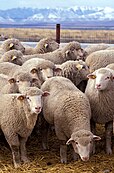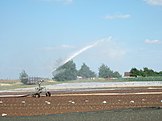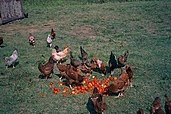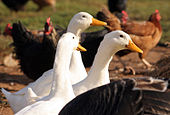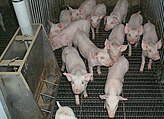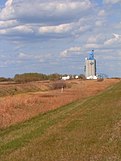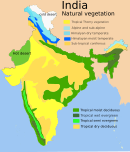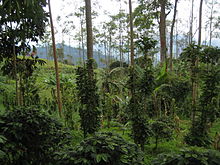Portal:Agriculture/Selected article
Source: Wikipedia, the free encyclopedia.
Purge server cache
Portal:Agriculture/Selected article/1

Butter sold in a London market, salted (right) and unsalted (left)
Butter is a
dairy product made from the fat and
protein components of churned
cream. It is a semi-solid
emulsion at
room temperature, consisting of approximately 80%
butterfat. It is used at room temperature as a
spread, melted as a
condiment, and used as a
fat in
baking,
sauce-making,
pan frying, and other cooking procedures.
Most frequently made from
, which is almost entirely butterfat.
Butter is a water-in-oil
refrigerated but softens to a spreadable consistency at
room temperature and melts to a thin liquid consistency at 32 to 35 °C (90 to 95 °F). The density of butter is 911 g/L (
15+1⁄4 oz/US pt). It generally has a pale yellow color but varies from deep yellow to nearly white. Its natural, unmodified color is dependent on the source animal's feed and genetics, but the commercial manufacturing process sometimes alters this with food colorings like
annatto or
carotene. (
Full article...) (
Full article...)
A
(early 19th century).
Honey bees are known for their construction of
)
Portal:Agriculture/Selected article/3
even-toed ungulates. Although the name "sheep" applies to many species in the genus
OvisSheep are most likely descended from the wild
for science.
Sheep farming is practised throughout the majority of the inhabited world, and has been fundamental to many civilizations. In the modern era, Australia, New Zealand, the southern and central South American nations, and the British Isles are most closely associated with sheep production. (Full article...)
Portal:Agriculture/Selected article/4

American long-grain rice plants
for a large part of the world's human population, especially in East and South Asia, the Middle East, Latin America, and the West Indies. It is the grain with the second-highest worldwide production, after maize (corn).
Since a large portion of maize crops are grown for purposes other than human consumption, rice is the most important grain with regard to human nutrition and caloric intake, providing more than one fifth of the calories consumed worldwide by the human species.
Rice is normally grown as an
ratoon crop for up to 30 years. The rice plant can grow to 1–1.8 m (3.3–5.9 ft) tall, occasionally more depending on the variety and soil fertility. It has long, slender leaves 50–100 cm (20–39 in) long and 2–2.5 cm (0.79–0.98 in) broad. The small
wind-pollinated flowers are produced in a branched arching to pendulous
inflorescence 30–50 cm (12–20 in) long. The edible seed is a grain (
caryopsis) 5–12 mm (0.20–0.47 in) long and 2–3 mm (0.079–0.118 in) thick. (
Full article...)
.
There is an increasing demand for fish and fish protein, which has resulted in widespread
)
A
fibres and, increasingly,
fuel. It is the basic production facility in
food production. Farms may be owned and operated by a single individual, family, community, corporation or a company. A farm can be a holding of any size from a fraction of a
hectareA business producing tree fruits or nuts is called an market garden or
truck farm is a farm that grows vegetables, but little or no grain. Additional specialty farms include
fish farms, which raise fish in captivity as a food source, and tree farms, which grow trees for sale for transplant, lumber, or decorative use. A
plantation is usually a large farm or estate, on which
cotton,
tobacco,
coffee or sugar cane, are cultivated, often by resident laborers. (
Full article...
Portal:Agriculture/Selected article/7
landscape plants, and
lawns. Irrigation has been a key aspect of
agriculture for over 5,000 years and has been developed by many cultures around the world. Irrigation helps to grow crops, maintain landscapes, and
revegetate disturbed soils in dry areas and during times of below-average rainfall. In addition to these uses, irrigation is also employed to protect crops from
frost, suppress
weed growth in
grain fields, and prevent
soil consolidation. It is also used to cool
livestock, reduce
dust, dispose of
sewage, and support
mining operations.
DrainageThere are several methods of irrigation that differ in how water is supplied to plants. Surface irrigation, also known as gravity irrigation, is the oldest form of irrigation and has been in use for thousands of years. In sprinkler irrigation, water is piped to one or more central locations within the field and distributed by overhead high-pressure water devices. Micro-irrigation is a system that distributes water under low pressure through a piped network and applies it as a small discharge to each plant. Micro-irrigation uses less pressure and water flow than sprinkler irrigation. Drip irrigation delivers water directly to the root zone of plants. Subirrigation has been used in field crops in areas with high water tables for many years. It involves artificially raising the water table to moisten the soil below the root zone of plants. (Full article...) (Full article...)
Portal:Agriculture/Selected article/8

Wheat
Wheat (
Triticum spp.) is a
grass, originally from the
Fertile Crescent region of the
Near East, but now cultivated worldwide. In 2007 world production of wheat was 607 million tons, making it the third most-produced
cereal after
maize (784 million tons) and
rice (651 million tons).
Globally, wheat is the leading source of vegetable protein in human food, having a higher protein content than either maize (corn) or rice, the other major cereals. In terms of total production tonnages used for food, it is currently second to rice as the main human food crop, and ahead of maize, after allowing for maize's more extensive use in animal feeds.
Wheat normally needs between 110 and 130 days between planting and
Zadoks scales being the most widely used. Each scale is a standard system which describes successive stages reached by the crop during the agricultural season. (
Full article...)
Portal:Agriculture/Selected article/9

Diversity in dry common beans
"Bean" is a common name for large plant
seeds of several
genera of the
family "
fabaceae" (alternately "leguminosae") used for human food or
animal feed.
The whole young pods of bean plants, if picked before the pods ripen and dry, are very tender and may be eaten cooked or raw. Thus the term "
.
Beans are one of the longest-
Broad beans, with seeds the size of the small fingernail, were gathered in their wild state in
Afghanistan and the Himalayan foothills. In a form improved from naturally occurring types, they were grown in Thailand already since the early seventh millennium (BC), predating ceramics. They were deposited with the dead in
ancient Egypt. Not until the second millennium BC did cultivated, large-seeded broad beans appear in the Aegean, Iberia and transalpine Europe. In the "
Iliad" (late-8th century) is a passing mention of beans and
chickpeas cast on the threshing floor. The oldest-known domesticated beans in the Americas were found in
Guitarrero Cave, an archaeological site in
Peru, and dated to around the second millennium BCE. (
Full article...)
Portal:Agriculture/Selected article/10
farming meat or eggs for
foodMore than 50 billion chickens are raised annually as a source of food, for both their meat and their
eggs. Chickens raised for meat are called
broilers, while those raised for eggs are called laying hens. In total, the UK alone consumes over 29 million eggs per day. Some hens can produce over 300 eggs a year. Chickens will naturally live for 6 or more years. After 12 months, the hen’s productivity will start to decline. This is when most commercial laying hens are slaughtered.
The majority of poultry are raised using intensive farming techniques. According to the Worldwatch Institute, 74 percent of the world's poultry meat, and 68 percent of eggs are produced this way. One alternative to intensive poultry farming is free range farming.
Friction between these two main methods has led to long term issues of ethical consumerism. Opponents of intensive farming argue that it harms the environment and creates health risks, as well as abusing the animals themselves. Advocates of intensive farming say that their highly efficient systems save land and food resources due to increased productivity, stating that the animals are looked after in state-of-the-art environmentally controlled facilities. A few countries have banned cage system housing, including Sweden and Switzerland, yet consumers can still purchase lower cost eggs from other countries' intensive poultry farms. (Full article...)
Portal:Agriculture/Selected article/11
. Poultry comes from the French/Norman word, poule, itself derived from the Latin word Pullus, which means small animal.
Poultry is the second most widely eaten meat in the world, accounting for about 30% of meat production worldwide, after pork at 38%.
Chicken meat contains about two to three times as much polyunsaturated fat than most types of red meat when measured as weight percentage. (Full article...)
Portal:Agriculture/Selected article/12
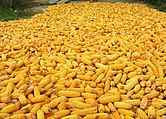
A heap of maize in India
Transgenic maize
(Genetically Modified Corn) made up 85% of the maize planted in the United States in 2009. While some maize varieties grow to 12 metres (39 ft) tall, most commercially grown maize has been bred for a standardized height of 2.5 metres (8.2 ft).
Maize is widely cultivated throughout the world, and a greater weight of maize is produced each year than any other grain. The United States produces 40% of the world's harvest; other top producing countries include
of maize were planted worldwide, with a yield of over 5 tonnes/hectare. Production can be significantly higher in certain regions of the world; 2009 forecasts for production in Iowa were 11614 kg/ha.
Maize was domesticated by
Olmec and
Mayans cultivated it in numerous varieties throughout central and southern
Mexico, cooked, ground or processed through
nixtamalization. Between 1700 and 1250 BCE, the crop spread through much of the
Americas. The region developed a trade network based on surplus and varieties of maize crops. After
European contact with the Americas in the late 15th and early 16th centuries, explorers and traders carried maize back to Europe and introduced it to other countries. Maize spread to the rest of the world due to its ability to grow in diverse climates. Sugar-rich varieties called
sweet corn are usually grown for human consumption, and are usually shorter in length than
field corn varieties, which are used for animal feed and as chemical feedstocks. (
Full article...)
Portal:Agriculture/Selected article/13
refers to aquaculture practised in marine environments.
The reported output from global aquaculture operations would supply one half of the fish and shellfish that is directly consumed by humans, however there are issues about the reliability of the reported figures. Further, in current aquaculture practice, products from several pounds of wild fish are used to produce one pound of a
salmon
.
Particular kinds of aquaculture include
)
Portal:Agriculture/Selected article/14
.
Pigs are amenable to many different styles of farming:
garbage
on a large scale.
All these forms of pig farm are in use today, though intensive farms are by far the most popular, due to their potential to raise a large amount of pigs in a very cost-efficient manner. In developed nations, commercial farms house thousands of pigs in climate-controlled buildings. Pigs are a popular form of livestock, with more than one billion pigs butchered each year worldwide, 100 million in the United States. The majority of pigs are used for human food, but also supply skin, fat and other materials for use in clothing, ingredients for processed foods, cosmetics, and medical use. (Full article...) (Full article...)
Portal:Agriculture/Selected article/15
cattle are sacred. It is estimated that there are 1.3 billion cattle in the world today. In 2009, cattle became the first livestock animal to have its
genome
Cattle are farmed for beef, veal, dairy, leather and they are less commonly used for conservation grazing, simply to maintain grassland for wildlife – for example, in Epping Forest, England. They are often used in some of the most wild places for livestock. Depending on the breed, cattle can survive on hill grazing, heaths, marshes, moors and semi-desert. Modern cows are more commercial than older breeds and, having become more specialized, are less versatile. For this reason many smaller farmers still favor old breeds, like the dairy breed of cattle Jersey. (Full article...)
Portal:Agriculture/Selected article/16
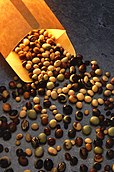
Varieties of soybeans are used for many purposes
The
pulse
by the Food and Agricultural Organisation (FAO).
Fat-free (defatted) soybean meal is a primary, low-cost source of protein for animal feeds and most
(TVP) are ingredients in many meat and dairy analogues. Soybeans produce significantly more protein per acre than most other uses of land.
Traditional nonfermented food uses of soybeans include
.
Soy varies in growth and habit. The height of the plant varies from below 20 cm (7.9 in) up to 2 metres (6.6 ft). The pods, stems, and leaves are covered with fine brown or gray hairs. The
trifoliolate, having three to four
leaflets per leaf, and the leaflets are 6–15 cm (2.4–5.9 in) long and 2–7 cm (0.79–2.76 in) broad. The leaves fall before the seeds are mature. The inconspicuous, self-fertile flowers are borne in the axil of the leaf and are white, pink or purple. The
fruit is a hairy
pod that grows in clusters of three to five, each pod is 3–8 cm long (1–3 in) and usually contains two to four (rarely more)
seeds 5–11 mm in diameter. (
Full article...)
berries,
nuts,
vegetables,
flowers,
trees,
shrubs, and
turf. Horticulturists work to improve crop yield, quality,
nutritional value, and resistance to
insects,
diseases, and environmental stresses. Horticulture usually refers to gardening on a smaller scale, while
agriculture refers to the large-scale cultivation of crops. (
Full article...
Portal:Agriculture/Selected article/18
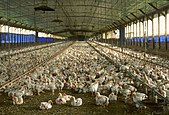
A commercial
chicken house raising broiler pullets for meat.
eggs
for human consumption. However, there have been issues regarding whether factory farming is sustainable and ethical.
Confinement at high stocking density is one part of a systematic effort to produce the highest output at the lowest cost by relying on economies of scale, modern machinery, biotechnology, and global trade. Confinement at high stocking density requires antibiotics and pesticides to mitigate the spread of disease and pestilence exacerbated by these crowded living conditions. In addition, antibiotics are used to stimulate livestock growth by killing intestinal bacteria. There are differences in the way factory farming techniques are practiced around the world. There is a continuing debate over the benefits and risks of factory farming. The issues include the efficiency of food production; animal welfare; whether it is essential for feeding the growing global human population; the environmental impact and the health risks.
The large concentration of animals, animal waste, and the potential for dead animals in a small space poses ethical issues. It is recognized that some techniques used to sustain intensive agriculture can be cruel to animals. As awareness of the problems of intensive techniques has grown, there have been some efforts by governments and industry to remove inappropriate techniques. (
Full article...
)
Portal:Agriculture/Selected article/19
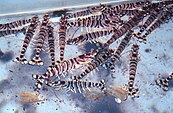
Shrimp in an aquaculture observation tank
A
are the largest producers. The largest exporting nation is Thailand.
Shrimp farming has changed from traditional, small-scale businesses in
Full article...
)
Portal:Agriculture/Selected article/22

Turkeys
The
domestic turkey is a large
poultry bird. The modern domesticated form descends from the
wild turkey (
Meleagris gallopavo), one of the two species of
turkey (genus
Meleagris); in the past the
ocellated turkey (
Meleagris ocellata) was also domesticated.
The turkey is raised throughout temperate parts of the world and is a popular form of poultry, partially because industrialized farming has made it very cheap for the amount of meat it produces. The female domesticated turkey is referred to as a hen and the chick as a poult. In the United States, the male is referred to as a tom, while in Europe, the male is a stag. The average lifespan for a domesticated turkey is ten years.
The great majority of domesticated turkeys are bred to have white feathers because their
pin feathers are less visible when the carcass is dressed, although brown or bronze-feathered varieties are also raised. The fleshy protuberance atop the beak is the
snood and the one attached to the underside of the beak is known as a
wattle.
Despite the name, turkeys have no direct relation to the country of Turkey and are native to North America; see further under Turkey (bird): History and naming. (Full article...)
Portal:Agriculture/Selected article/23
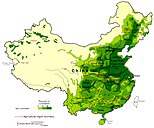
A rough map of agricultural regions in China
Communist Party of China's victory in the
Chinese Civil War, control of the farmlands was taken away from landlords and redistributed to the 300 million peasant farmers. In 1952, gradually consolidating its power following the civil war, the government began organizing the peasants into teams. Three years later, these teams were combined into producer cooperatives, enacting the
SocialistAs China continues to industrialize, vast swaths of agricultural land is being converted into industrial land. Farmers displaced by such urban expansion often become
, but other farmers feel disenfranchised and cheated by the encroachment of industry and the growing disparity between urban and rural wealth and income.
The most recent innovation in Chinese agriculture is a push into organic agriculture. This rapid embrace of organic farming simultaneously serves multiple purposes, including food safety, health benefits, export opportunities, and by providing price premiums for the produce of rural communities, the adoption of organics can help stem the migration of rural workers to the cities. In the mid 1990s China became a net importer of grain, since its unsustainable practices of groundwater mining has effectively removed considerable land from productive agricultural use. (Full article...)
Portal:Agriculture/Selected article/24
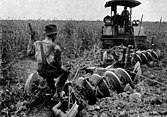
A photo from a 1921 encyclopedia shows a
tractor ploughing an
alfalfa field
U.S. farm bills. Governance is both a federal and a local responsibility with the
United States Department of Agriculture being the federal department responsible. Government aid includes research into crop types and regional suitability as well as many kinds of subsidies, some price supports and loan programs. American farmers are not subject to
production quotasCorn, turkeys, tomatoes, potatoes, peanuts, and sunflower seeds constitute some of the major holdovers from the agricultural endowment of the Americas. European agricultural practices greatly affected the New England landscape, leaving behind many physical foot prints. Colonists brought livestock over from Europe which caused many changes to the land. Grazing animals required a lot of land and food to sustain them and due to grazing, native grasses were destroyed and European species began to replace them. New species of weeds were introduced and began to thrive as they were capable of withstanding the grazing of animals, whereas native species could not.
In 2004, of the 145 million employed workers in the US, 834,000 of them held jobs as agricultural workers. 83% of these jobs were as farm workers. The median hourly income as of May 2004[update] was $7.70 for farmworkers planting, growing and harvesting crops, and $8.31 for farmworkers tending to animals. (Full article...)
Portal:Agriculture/Selected article/25

Soy field in Argentina's fertile
pampas. The versatile
legume makes up about half the nation's crop production and a fourth of its exports.
Agriculture is one of the bases of
Argentina's economy. Argentine agriculture is relatively capital intensive, today providing about 7% of all employment and, even during its period of dominance around 1900, accounting for no more than a third of all labor. Having accounted for 20% of GDP as late as 1959, it adds, directly, less than 10% today; however, agricultural goods, whether raw or processed, still earn over half of Argentina's foreign exchange and, arguably, remain an indispensable pillar of the country's social progress and economic prosperity.
An estimated 10-15% of argentinian farmland is foreign owned.
In 2007, more than one fifth of Argentine exports of about US$56 billion were composed of unprocessed agricultural primary goods, mainly soybeans, wheat and maize. A further one third were composed of processed agricultural products, such as animal feed, flour and vegetable oils. The national governmental organization in charge of overseeing agriculture is the Secretariat of Agriculture, Cattle Farming, Fishing and Food (Secretaría de Agricultura, Ganadería, Pesca y Alimentos, SAGPyA).
)
Portal:Agriculture/Selected article/26

Soviet Union stamp, the seven-year plan, grain; 1959, 20 kop., used, CPA No. 2345.
Agriculture in the Soviet Union was organized into a system of state and collective farms, known as
sovkhozes and
kolkhozes, respectively. Following a grain crisis in 1928,
Joseph Stalin established the USSR's system of state and collective farms when he moved to replace the
NEP with collective farming, which grouped peasants into collective farms (
kolkhozes) and state farms (
sovkhozes). Organized on a large scale and relatively highly mechanized, the Soviet Union was one of the world's leading producers of cereals, although bad harvests (as in 1972 and 1975) necessitated imports and slowed the economy. The 1976-1980 five-year plan shifted resources to agriculture, and 1978 saw a record harvest.
Cotton,
sugar beets,
potatoes, and
flax were also major crops.
However, despite immense land resources, extensive machinery and chemical industries, and a large rural work force, Soviet agriculture was relatively unproductive, hampered in many areas by the climate (only 10 percent of the Soviet Union's land was arable), and poor worker productivity. Conditions were best in the temperate black earth belt stretching from Ukraine through southern Russia into the west, spanning the extreme southern portions of Siberia.
Stalin's campaign of forced collectivization was a major factor explaining the sector's poor performance. Collectivization relied on a system of internal passports to keep farmers tied to the land. This has been referred to as a form of "neo-serfdom", in which the Communist bureaucracy replaced the former landowners. The first response of most farmers to this loss of freedom was to slaughter and consume their farm animals. In the new state and collective farms, outside directives failed to take local growing conditions into account. Also, interference in the day-to-day affairs of peasant life often bred resentment and worker alienation across the countryside. The human toll was very large with millions, perhaps as many as 3 million, dying from famine in the wake of collectivisation. In the collective and state farms, low labor productivity was a consequence for the entire Soviet period.
The claims of inefficiency have, however, been criticized by Economist Joseph E. Medley of the University of Southern Maine, US. Statistics based on value rather than volume of production may give one view of reality, as public-sector food was heavily subsidized and sold at much lower prices than private-sector produce. In addition, the 2–3% of arable land allotted as private plots does not include the large area allocated to the peasants as pasturage for their private livestock; combined with land used to produce grain for fodder, the pasturage and the private plots total almost 20% of all Soviet farmland. Private farming may also be relatively inefficient, taking roughly 40% of all agricultural labor to produce only 26% of all output by value. Another problem is these criticisms tend to discuss only a small number of consumer products and do not take into account the fact that the kolkhozy and sovkhozy produced mainly grain, cotton, flax, forage, seed, and other non-consumer goods with a relatively low value per unit area. This economist admits to some inefficiency in Soviet agriculture, but claims that the failure reported by most Western experts would only be a myth. (Full article...)
Portal:Agriculture/Selected article/27
Canada is one of the largest agricultural producers and exporters in the world. As with other developed nations, the proportion of the population and GDP devoted to agriculture fell dramatically over the 20th century but it remains an important element of the Canadian economy.
A wide range of agriculture is practiced in Canada, from sprawling wheat fields of the
.
Agriculture in Canada comprises five main agricultural production sectors of commodity production resulting in farm cash receipts from both domestic and foreign markets.
Horticulture which includes garden crops, and fruits became easier to grow with the development of plant hardiness zones.
.
and beet root sugar are harvested in Quebec, Ontario, Manitoba, and Alberta.
115,000 cattle roamed the southern prairies by 1900.
)
Portal:Agriculture/Selected article/28

USDA Hardiness Zones in North America
A
hardiness zone (a subcategory of Vertical Zonation) is a geographically defined area in which a specific category of
plant life is capable of growing, as defined by climatic conditions, including its ability to withstand the minimum temperatures of the zone (see the scale on the right or the table below). For example, a plant that is described as "hardy to zone 10" means that the plant can withstand a minimum temperature of -1°C. A more resilient plant that is "hardy to zone 9" can tolerate a minimum temperature of -7°C. First developed for the United States by the
Department of Agriculture (USDA), the use of the zones has been adopted by other nations.
Based on the average annual minimum temperature for a given location, the USDA map provides an easy guideline for categorizing locations suitable for winter survival of a rated plant in an "average" winter. Since temperatures in the non-coastal-adjacent areas of the continent rarely present a consistent experience from year to year, and occasionally present a major—and often agriculturally devastating—deviation from the average minimum, the map has limitations for much of the country as a basis for using with long-term reliability, at least in areas close to the margin of a plant's rated hardiness-zone.
In 2003, the
National Arbor Day Foundation completed an extensive updating of U.S. Hardiness Zones. It used essentially the same data as the AHS. Once the Foundation analyzed the new data, it revised hardiness zones, reflecting the generally warmer recent temperatures in many parts of the country. The Foundation's 2006 map appears to validate the data used in the AHS 2003 draft. The Foundation also did away with the more detailed a/b half-zone delineations. (
Full article...)
Portal:Agriculture/Selected article/29
Agriculture in India has a significant
history. Today, India
ranks second worldwide in farm output.
Agriculture and allied sectors like
forestry and
logging accounted for 16.6% of the GDP in 2007, % of the total workforce and despite a steady decline of its share in the GDP, is still the largest economic sector and plays a significant role in the overall social-economic development of India.
India is the largest producer in the world of fresh fruit,
sapota
.
India's population is growing faster than its ability to produce rice and wheat.
Per the World Bank's "India Country Overview" in 2008:
"Slow agricultural growth is a concern for policymakers as some two-thirds of India’s people depend on rural employment for a living. Current agricultural practices are neither economically nor environmentally sustainable and India's yields for many agricultural commodities are low. Poorly maintained irrigation systems and almost universal lack of good extension services are among the factors responsible. Farmers' access to markets is hampered by poor roads, rudimentary market infrastructure, and excessive regulation."
— World Bank: "India Country Overview 2008"
(
Full article...)
Portal:Agriculture/Selected article/30
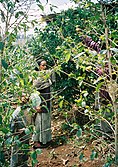
An Ethiopian family working in their backyard fruit orchard
Agriculture in Ethiopia is the foundation of the country's economy, accounting for half of
gross domestic product (GDP), 83.9% of
exports, and 80% of total employment.
, high population density, high levels of taxation and poor infrastructure (making it difficult and expensive to get goods to market). Yet agriculture is the country's most promising resource. A potential exists for self-sufficiency in grains and for export development in livestock, grains, vegetables, and fruits. As many as 4.6 million people need food assistance annually.
Agriculture accounts for 46.3% of the GDP, 83.9% of exports, and 80% of the labour force. Many other economic activities depend on agriculture, including marketing, processing, and export of agricultural products. Production is overwhelmingly of a subsistence nature, and a large part of commodity exports are provided by the small agricultural cash-crop sector. Principal crops include
pulses (
e.g., beans),
oilseeds,
cereals, potatoes,
sugarcane, and vegetables. Exports are almost entirely agricultural commodities, and coffee is the largest foreign exchange earner. Ethiopia is Africa's second biggest maize producer. Ethiopia's
livestock population is believed to be the largest in Africa, and in 2006/2007 livestock accounted for 10.6% of Ethiopia's export income, with leather and leather products making up 7.5% and live animals 3.1%.
Ethiopi's major
enjera, an sourdough pancakelike bread that is the principal form in which grain is consumed in the highlands and in urban centers throughout the country. Barley is grown mostly between 2,000 and 3,500 meters. A major subsistence crop, barley is used as food and in the production of
tella, a locally produced beer.
Sorghum, millet, and corn are cultivated mostly in warmer areas at lower altitudes along the country's western, southwestern, and eastern peripheries. Sorghum and millet, which are drought resistant, grow well at low elevations where rainfall is less reliable. Corn is grown chiefly between elevations of 1,500 and 2,200 meters and requires large amounts of rainfall to ensure good harvests. These three grains constitute the staple foods of a good part of the population and are major items in the diet of the nomads.
Pulses are the second most important element in the national diet and a principal protein source. They are boiled, roasted, or included in a stew-like dish known as wot, which is sometimes a main dish and sometimes a supplementary food. Pulses, grown widely at all altitudes from sea level to about 3,000 meters, are more prevalent in the northern and central highlands. Pulses were a particularly important export item before the revolution. (Full article...)
agricultural technologies despite the fact that the geography of Israel is not naturally conducive to
agriculture. More than half of the land area is
desert, and the
climate and lack of
waterIsrael is home to two unique types of agricultural communities, the kibbutz and moshav, which developed as Jews from all over the world immigrated to the country and embarked on a pioneering enterprise.
The importance of agriculture in Israel's economy has fallen over time, accounting for decreasing values of
)
